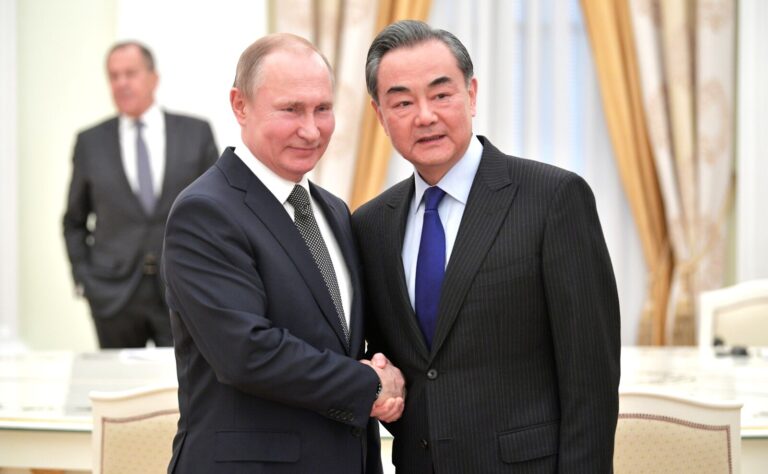
In January, Ukrainian president Volodymyr Zelenskyy said in an interview that he would not allow China to take control of Ukrainian enterprise Motor Sich.
“Never… not under me. I am not here for life… [But] in my time [in office], definitely not,” he stated.
Such rhetoric is completely new in the history of Sino-Ukrainian defense relations, and could mean a gradual cooling of ties between Kyiv and Beijing.
Bilateral military-technical cooperation has traditionally occupied an important space in relations between the two countries. Facing the post-Tiananmen arms embargo enacted by the EU, China turned to Ukraine as a source of military technologies, shoring up supply chains for aircraft construction, space industry and the Navy. For Ukraine, the supply of defense products and technologies to China allowed the nation to develop additional industrial sectors, promote the high-tech component of its emerging economy and promote profitable business interests overall.
However, due to the growing confrontation between the US and China, and the military conflict between Ukraine and Russia, new barriers and risks jeopardize the profitable military-technical cooperation between Ukraine and China.
Key Projects
Defense cooperation has traditionally been one of the most sensitive and opaque spheres of bilateral relations, with the overwhelming majority of transactions and joint projects remaining undisclosed.
However, from those that have been publicized, several stand out.
In 1998, China purchased the Ukrainian aircraft-carrier Varyag, which was later upgraded and introduced into the PLA Navy (PLAN) under the name Liaoning. As the first aircraft carrier in the PLAN, it became the basis for further development of the Chinese industry in the field of aircraft-carrying ships. The first aircraft carrier built by the Chinese industry, “Shandong”, has a design similar to the Liaoning.
Another field of cooperation involved gas turbine installations for the Chinese Navy. At one time, Chinese destroyers were equipped with American-made General Electric LM2500 gas turbines. However, after the US imposed an arms embargo Beijing turned to Ukraine, where it acquired 10 UGT 25000 gas turbine engines along with full technical documentation. On the basis of the UGT 25000 gas turbine, Chinese gas turbines QC 280 were developed, which are equipped with new destroyers of the Type 055 (Nanchan-class) with a displacement of up to 12 thousand tons.
Ukraine also delivered small amphibious assault ships Bizon to China. The first was sent to China in April 2013, the second on March 1, 2014 – the eve of the annexation of Crimea. While two vessels were built at the More Shipyard in Feodosia, Crimea, the other two were produced in China, probably with Ukrainian technical assistance. In addition to the transferred ships, China received a full technical documentation.
Last, but not least, China has sourced aircraft engines in Ukraine, including the AI-322 and AI-222-25 manufactured by Motor Sich, for Chinese L-15 combat training aircraft. This aircraft was designed on the basis of the Russian Yak-130 aircraft, but the Chinese side preferred the Ukrainian engine to the Russian one.
According to the SIPRI, the volume of Ukrainian exports to China is estimated at approximately $80-90 million annually, although exact figures are unclear due to peculiarities of methodology.
General Director of Ukrspetsexport Vadim Nozdria, estimated the sale of weapons and services to China at $70 million, mentioning China as one of the most important markets for Ukraine together with Turkey and Pakistan. According to Nozdria, two countries are working together to improve the characteristics of the aircraft engine for the Chinese fifth generation fighter and naval projects such as marine radars and engines for ships, which are being developed by the Ukrainian enterprise Zorya-Mashproekt.
Per financial statements from the manufacturer of gas turbine equipment Zorya-Mashproekt, from 2018 to 2019 China ranked second in terms of the turnover of supplied products, with a share of 15.3 per cent in 2019. As far as aircraft engines are concerned, most likely, it applies to the products of Motor Sich, which supplies engines for the Chinese L-15 combat training aircraft.
Risks Abound
While China has been a crucial partner for Ukraine’s defense industry, there has been no shortage of risks. The military-technical cooperation between Ukraine and China has been one-sided as the equipment and technologies were sourced from Ukraine to China. However, Kyiv failed to establish joint production in Ukraine with the participation of Chinese companies, and also failed to become full partners of Chinese production sites. A series of negotiations on the establishment of a Chinese-Ukrainian aircraft plant in Odessa (Ukraine) did not bring any positive results.
Moreover, the risk was that having received the appropriate technologies, China would steal the intellectual property and use it for independent manufacturing of its own products. With significant production advantages and huge economic resources, China could squeeze Ukraine out of the global arms market. For example, in 2002, Ukraine supplied China with two sets of automated electronic warfare systems Mandat-B1E which are used to suppress ground-based radio stations. Now the antenna and electronic warfare system, similar to those installed in Mandat-B1E, appear in the catalog of the Chinese company China Electronic Technology Import & Export Corporation.
However, it was China’s attempt to gain control over the key Ukrainian company Motor Sich that really put the spotlight on the potential risks. Against the background of the poor financial situation of the Ukrainian enterprise after the termination of contracts with Russia in 2014, the Chinese company Beijing Skyrizon Aviation Industry Investment acquired a controlling stake in Motor Sich in 2016.
In 2017, the Security Service of Ukraine stopped the deal, opening a criminal case on the basis of “sabotage and destruction of the enterprise.” The situation remained in limbo, until the US Department of Commerce added the Chinese company Skyrizon to the Military End Users list on January 14 this year due to ties to China and People’s Liberation Army. According to Washington, “Skyrizon is actively seeking to acquire intellectual property and technology to advance key military capabilities that threaten US national security, including the capability to develop, produce, or maintain military items, such as aircraft engines, satellites, and cruise missiles.”
According to Kiev-based CACDS’s military specialists, the cooperation of the Motor Sich with the Skyrizon creates a number of both internal and external threats to Ukraine. For example, in the event that the Chinese gain control over the enterprise, Ukraine’s capabilities for the development of aircraft and missile programs in the interests of the Armed Forces of Ukraine and for export would be significantly reduced.
Also, experts mentioned the possibility of critical technology being laundered to Russia, via Chinese companies, particularly in connection with the implementation of joint Chinese-Russian programs in the helicopter industry.
Finally, Ukraine could see the development of military-political, military-technical and military cooperation with NATO and EU partners threatened. This includes a number of promising projects in the field of aviation, navy ships, air defense and missile defense, which are now urgently needed to build an effective defense system in the context of a military conflict with Russia.
Based on these and other concerns, the Ukrainian government began the process of nationalization of the Motor Sich enterprise, drawing criticism from Beijing.
Westward Push
Geopolitical concerns have played an ever greater role in Ukraine’s view of the issue. After the illegal annexation of Crimea by Russia and the beginning of Russia’s aggression in eastern Ukraine, Moscow has been trying to a greater extent to apply pressure on Ukraine with political and economic instruments. In these conditions, the key tasks for Ukraine are to ensure military security and stable economic development.
To achieve these goals, Ukraine has chosen the Euro-Atlantic and European path of development, which includes building defense systems according to NATO standards and with full compatibility of weapons and military standards with the armies of the Alliance. Ukraine is also strengthening military-political and military-technical cooperation with NATO and partners on a bilateral basis, including with the US, UK, Turkey, Canada, and others. Lastly, Ukraine is carrying out comprehensive reforms in politics and economy in order to achieve convergence with the EU, including on the issue of the EU’s arms embargo on China.
In this regard, it is expected that Ukraine will gradually reduce its defense cooperation with China, primarily in those weapons that can bring the PLA a strategic advantage in the South China and East China Seas and can threaten the interests of the US and its allies in the Asia-Pacific.
Responding to the challenges associated with China’s attempt to take over Motor Sich, Ukraine will defend its national interests, preventing China from gaining control over Ukrainian strategic enterprises. This will also be facilitated by the law on screening foreign investments for threats to national security, the draft of which has already been approved by the government.
While it will not be easy for Ukraine to abandon the attractive Chinese market, the military-technical cooperation with Western partners, such as Boeing’s cooperation with Antonov, will have to compensate at least in part for the loss.
Written by
Yurii Poita
PoitaYuriiYurii Poita is the Head of the Asia-Pacific Section at the Center for Army, Conversion and Disarmament Studies (CACDS) in Kyiv. He is also a Futures Fellow at Mercator Institute for China Studies (MERICS). Yurii specializes in China's influence in the post-Soviet space, Ukrainian-Chinese relations, regional security issues and hybrid methods of influence.


